
The Ducal Palace or Palazzo Ducale of Atina is a 14th-century gothic-style, government palace in Piazza Saturno, in the center of the town of Atina, province of Rieti, region of Lazio, Italy.

The Ducal Palace or Palazzo Ducale of Atina is a 14th-century gothic-style, government palace in Piazza Saturno, in the center of the town of Atina, province of Rieti, region of Lazio, Italy.
The town of Atina was leveled by an earthquake on 9 September 1349. Reconstruction was patronized by the aristocratic Cantelmo family. The town was rebuilt at the original site of the Ancient Roman town, and a hamlet built by the Counts of Aquino. The Duke of Alvito, Rostaino Cantelmo, decided to build the fortress-like palace in the highest point in the town. Construction lasted over two centuries. In the meantime, feudal owner ship of the town underwent many changes. In 1595, the palace was bought by the Gallio family. But by the 18th century it became property of the Paniccia family of Vicalvi. In 1870, it was sold to the town council. For a period it was used as a prison. In the early 1900s, the palace housed a theatre and hall for meeting, modified by Giuseppe Visocchi.
The tall facade has three mullioned windows and above three oval rose windows. The main portal has a pointed Gothic arch. Above the entrance is an Ancient Roman spolia, poorly conserved, of a low relief depicting a votive offering, dating to the first Imperial period. To the right of the portal is an Ancient Roman statue, presumably of a high ranking official, but nicknamed Pasquino. Flanking the facade are two medieval rectangular towers.
The first floor has a large hall, which displays Ancient Roman floor mosaics from the 2nd century BC. The mosaics depict armed Samnite warriors set between panels of geometrical designs. This mosaic was discovered in 1946 during excavations in Via Virilassi in the town. On the second floor is another large hall, and the chapel of San Onofrio. The chapel has 14th century frescoes depicting the Madonna and Child with St. John the Baptist, Christ in Glory and the saints Onofrio, John the Evangelist and Michael the Archangel. The palace also preserves frescoes detached from the local church of San Marco. They depict Martyrdom of St Dario and Scenes of Courtly Life.
The palace now serves as the Town Hall, the Register Office, and a display on the archeology of the region. [1]

A mosaic is a pattern or image made of small regular or irregular pieces of colored stone, glass or ceramic, held in place by plaster/mortar, and covering a surface. Mosaics are often used as floor and wall decoration, and were particularly popular in the Ancient Roman world.
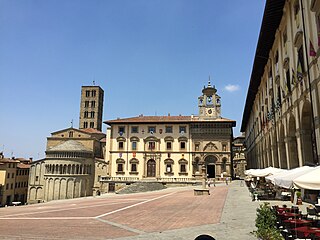
Arezzo is a city and comune in Italy and the capital of the province of the same name located in Tuscany. Arezzo is about 80 kilometres southeast of Florence at an elevation of 296 metres (971 ft) above sea level. As of 2022, the population was about 97,000.

Aachen Cathedral is a Catholic church in Aachen, Germany and the seat of the Diocese of Aachen.
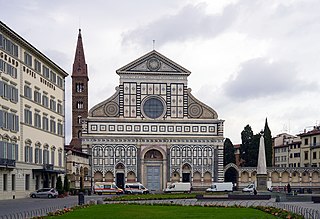
Santa Maria Novella is a church in Florence, Italy, situated opposite, and lending its name to, the city's main railway station. Chronologically, it is the first great basilica in Florence, and is the city's principal Dominican church.

Todi is a town and comune (municipality) of the province of Perugia in central Italy. It is perched on a tall two-crested hill overlooking the east bank of the river Tiber, commanding distant views in every direction. It was founded in antiquity by the Umbri, at the border with Etruria; the family of Roman Emperor Trajan came from Todi.
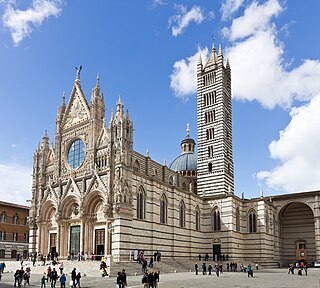
Siena Cathedral is a medieval church in Siena, Italy, dedicated from its earliest days as a Roman Catholic Marian church, and now dedicated to the Assumption of Mary.

The Palazzo Vecchio is the town hall of Florence, Italy. It overlooks the Piazza della Signoria, which holds a copy of Michelangelo's David statue, and the gallery of statues in the adjacent Loggia dei Lanzi.

Buda Castle is the historical castle and palace complex of the Hungarian Kings in Budapest. It was first completed in 1265, although the massive Baroque palace today occupying most of the site was built between 1749 and 1769. The complex in the past was referred to as either the Royal Palace or the Royal Castle. The castle now houses the Hungarian National Gallery and the Budapest Historical Museum.

Cagli is a town and comune in the province of Pesaro e Urbino, Marche, central Italy. It c. 30 kilometres south of Urbino. The Burano flows near the town.

Castelbuono is a town and comune in the Metropolitan City of Palermo, Sicily.
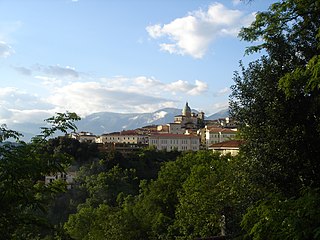
Atina is a town and comune in the province of Frosinone, Lazio region of central Italy. It is one of I Borghi più belli d'Italia. The economy is mostly based on agriculture.

Pacentro is a comune of 1,279 inhabitants of the province of L'Aquila in Abruzzo, Italy. It is a well-preserved historic medieval village located in central Italy, several kilometers from the City of Sulmona about 170 kilometres (110 mi) east of Rome. It is one of I Borghi più belli d'Italia.

Orvieto Cathedral is a large 14th-century Roman Catholic cathedral dedicated to the Assumption of the Virgin Mary and situated in the town of Orvieto in Umbria, central Italy. Since 1986, the cathedral in Orvieto has been the episcopal seat of the former Diocese of Todi as well.

Gallavresi Palace is a public building dating back, by all accounts, to the second half of the 13th century, which lies in the historical centre of the town of Caravaggio, in Lombardy, northern Italy; it has been see to the town administration since 1947.
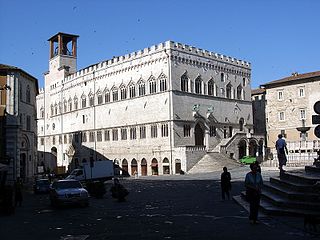
The Palazzo dei Priori or comunale is one of the best examples in Italy of a public palace from the communal era. It is located in the central Piazza IV Novembre in Perugia, Umbria. It extends along Corso Vannucci up to Via Boncambi. It still houses part of the municipality, and, on the third floor, the Galleria Nazionale dell'Umbria. It takes its name from the Priori, the highest political authority governing the city in the medieval era.

San Cristoforo sul Naviglio is a church in Milan, northern Italy.

Montisi is an Italian village in the municipality of Montalcino, Province of Siena, Tuscany. It sits on a hill on the boundary between the Val d'Orcia and the Crete Senesi.

The Palazzo dei Consoli is a Gothic architecture, civic building in the historic center of Gubbio, region of Umbria, Italy. Construction took place during 1332–1349 under design by Angelo da Orvieto; the palace was built on a large platform built against the hillside and looming over the town below.

San Fortunato is a Gothic- and Renaissance-style, Roman Catholic church located on Piazza Umberto I #6 in the historic center of Todi, province of Perugia, region of Umbria, Italy.
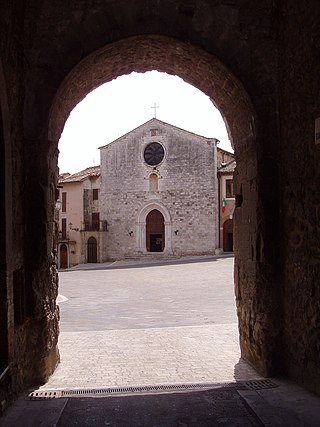
San Francesco is a Gothic-style, Roman Catholic, church in a piazza of the same name in the town of San Gemini, region of Umbria, Italy. The 13-14th-century church was erected by the Franciscan order and dedicated to St Francis, who visited the town at least twice in his lifetime.